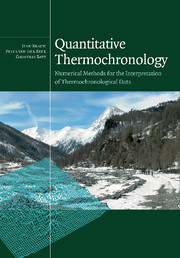Book contents
- Frontmatter
- Contents
- Preface
- 1 Introduction
- 2 Basics of thermochronology: from t–T paths to ages
- 3 Thermochronological systems
- 4 The general heat-transport equation
- 5 Thermal effects of exhumation
- 6 Steady-state two-dimensional heat transport
- 7 General transient solution – the three-dimensional problem
- 8 Inverse methods
- 9 Detrital thermochronology
- 10 Lateral advection of material
- 11 Isostatic response to denudation
- 12 The evolution of passive-margin escarpments
- 13 Thermochronology in active tectonic settings
- Appendix 1 Forward models of fission-track annealing
- Appendix 2 Fortran routines provided with this textbook
- Appendix 3 One-dimensional conductive equilibrium with heat production
- Appendix 4 One-dimensional conductive equilibrium with anomalous conductivity
- Appendix 5 One-dimensional transient conductive heat transport
- Appendix 6 Volume integrals in spherical coordinates
- Appendix 7 The complementary error function
- Appendix 8 Pecube user guide
- Appendix 9 Tutorial solutions
- References
- Index
13 - Thermochronology in active tectonic settings
Published online by Cambridge University Press: 15 December 2009
- Frontmatter
- Contents
- Preface
- 1 Introduction
- 2 Basics of thermochronology: from t–T paths to ages
- 3 Thermochronological systems
- 4 The general heat-transport equation
- 5 Thermal effects of exhumation
- 6 Steady-state two-dimensional heat transport
- 7 General transient solution – the three-dimensional problem
- 8 Inverse methods
- 9 Detrital thermochronology
- 10 Lateral advection of material
- 11 Isostatic response to denudation
- 12 The evolution of passive-margin escarpments
- 13 Thermochronology in active tectonic settings
- Appendix 1 Forward models of fission-track annealing
- Appendix 2 Fortran routines provided with this textbook
- Appendix 3 One-dimensional conductive equilibrium with heat production
- Appendix 4 One-dimensional conductive equilibrium with anomalous conductivity
- Appendix 5 One-dimensional transient conductive heat transport
- Appendix 6 Volume integrals in spherical coordinates
- Appendix 7 The complementary error function
- Appendix 8 Pecube user guide
- Appendix 9 Tutorial solutions
- References
- Index
Summary
The coupling between erosion and tectonics is most likely to be efficient in regions of ongoing tectonic activity, especially in regions of continental convergence where the collision between two continents leads to crustal thickening and, by isostasy, to surface uplift. This uplift causes relief (i.e. slope) to be created, which triggers erosion by channel incision or, under colder climatic conditions, the formation of glaciers that will rapidly reshape the landform.
In this chapter, we are going to investigate the effect of continental collision on the temperature structure of the crust; we will also present some of the most widely accepted models for crustal deformation and, most importantly, describe the respective consequences they have for the path followed by rock particles as they travel through the orogen, ultimately to be exposed at the surface. The combination of these processes will provide us with appropriate (that is, quantitative) constraints on the predicted temperature history of particles from which we should be able to predict cooling ages.
At the end of this chapter we will demonstrate how these predictions can then be used to constrain the tectonic evolution of an active mountain belt, including the timing of the onset of convergence, the present-day rate of convergence and its variation along the strike of the orogen. To illustrate this approach, we will consider a dataset collected in the Southern Alps of New Zealand that has been interpreted using state-of-the-art quantitative methods (Batt and Braun, 1999; Herman et al., 2006).
- Type
- Chapter
- Information
- Quantitative ThermochronologyNumerical Methods for the Interpretation of Thermochronological Data, pp. 192 - 206Publisher: Cambridge University PressPrint publication year: 2006



